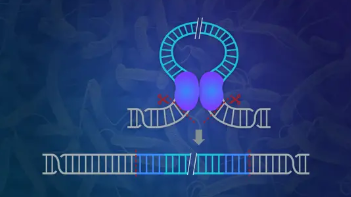
This blog explores the fascinating world of ‘jumping genes’—also known as transposons—and how they move within the genome, especially during cell division. Learn how these mobile genetic elements can disrupt DNA sequences, influence genetic expression, cause mutations, and even contribute to evolution and certain diseases. A deep dive into one of biology’s most intriguing phenomena.
In the intricate world of genetics, certain DNA elements behave like molecular nomads. These are transposable elements, often called "jumping genes." Unlike regular genes that stay put, these elements can move around within the genome, inserting themselves into new locations.
Among them, a particularly persistent type known as LINE-1 (Long Interspersed Nuclear Element-1) has caught scientists’ attention. It makes up about 20% of the human genome, yet it operates like a virus, jumping from place to place.
Historically, viruses are known to hijack our cells' machinery to reproduce. In the process, some viruses leave genetic scars—little bits of their genome—within our own. Over millions of years, these viral remnants evolved into transposable elements.
Most of these viral-like sequences are dormant, silenced by cellular defenses. But LINE-1 remains active, still capable of copying itself and jumping to new locations in the genome.
LINE-1 acts like a retrovirus, such as HIV. It uses a two-step copying process:
Transcription: LINE-1 is copied into RNA.
Reverse transcription: That RNA is then turned back into DNA, but in a new spot in the genome.
Each successful jump adds more LINE-1 code to the human genome, leading to its massive presence today.
This might seem fascinating, but there’s a dark side. LINE-1 insertions can:
Disrupt essential genes, leading to neurological disorders and cancer.
Trigger immune responses, causing inflammation.
Contribute to aging.
At the same time, LINE-1 and similar elements drive evolution by creating genetic diversity.
One major hurdle LINE-1 faces is entering the nucleus—the inner chamber of a cell where DNA is stored and protected.
Under normal conditions, the nucleus is sealed. But during cell division, especially in mitosis, the nucleus temporarily breaks open, allowing new genetic material to be shuffled in and out.
A new study, published in Science Advances, has revealed that LINE-1 seizes this opportunity window. When the nuclear envelope dissolves during cell division, LINE-1 sneaks in.
LINE-1 encodes two proteins, and one of them is called ORF1p. This protein has unique properties:
It binds to RNA, DNA, and itself.
It forms large molecular clusters called multimers.
As more ORF1p accumulates, it forms condensates—dense molecular packages containing hundreds of ORF1p molecules and LINE-1 RNA.
These condensates:
Help LINE-1 stick to DNA.
Allow LINE-1 to evade cellular defenses during mitosis.
Act like delivery vehicles, guiding LINE-1 to insert into parts of the DNA rich in adenine (A) and thymine (T)—preferred insertion zones.
The key discovery was that LINE-1 only binds to DNA when enough ORF1p and RNA are present in these condensates.
Understanding how LINE-1 operates gives scientists a potential target for therapies. If we can prevent LINE-1 from forming condensates or binding DNA, we may be able to:
Slow down aging.
Prevent genetic diseases.
Treat certain cancers.
The study also raises questions about other types of condensates in the cell:
Could their functions change based on the ratios of their components?
Do other transposable elements use similar strategies?
These are open questions researchers are now eager to explore.
Jumping genes like LINE-1 are both dangerous and essential. They shape our DNA, contribute to evolution, but also pose significant health risks. Thanks to recent discoveries, we now understand how LINE-1 invades the genome—not randomly, but through a cleverly timed infiltration during cell division.
This insight opens doors to new ways of controlling these rogue elements, potentially altering how we treat genetic diseases and understand human evolution.
1. What percentage of the human genome is made up of LINE-1 elements?
A. 5%
B. 10%
C. 20%
D. 50%
Answer: C. 20%
2. What does LINE-1 need to enter the nucleus and bind to DNA?
A. Ribosomes
B. ORF1p condensates
C. White blood cells
D. RNA polymerase
Answer: B. ORF1p condensates
3. What type of genetic element is LINE-1 classified as?
A. Plasmid
B. Chromosome
C. Retrotransposon
D. Telomere
Answer: C. Retrotransposon
4. During which cellular event does LINE-1 gain access to the nucleus?
A. DNA replication
B. Cell death
C. Cell division (mitosis)
D. Transcription
Answer: C. Cell division (mitosis)
5. What is the function of the ORF1p protein in LINE-1 movement?
A. Degrading DNA
B. Preventing cell division
C. Forming condensates to bind DNA
D. Making antibodies
Answer: C. Forming condensates to bind DNA
1. Discuss the dual role of transposable elements like LINE-1 in human evolution and disease. (250 words)
Hint: Consider both genetic diversity and genome instability.
2. Explain the role of ORF1p protein in facilitating LINE-1 insertion into the genome. How might targeting ORF1p contribute to therapeutic development? (150 words)
3. "LINE-1 retrotransposons are remnants of ancient viral infections." Critically analyze this statement in the context of genome evolution and genetic regulation. (200 words)
11-Jul-2025 02:29 PM
Explore the fascinating structure, origin, and dynamics of our Earth—from...
11-Jul-2025 02:18 PM
Understand the vital role of lysosomes and cellular transmission in...
11-Jul-2025 01:48 PM
A concise and exam-focused overview of Plasmolysis and Protoplasm, covering...
04-Jul-2025 12:46 PM
India’s education system is undergoing a major transformation to prepare...
02-Jul-2025 02:51 PM
Recent research suggests that the transfer of genes between fungi...
02-Jul-2025 02:44 PM
Operation Sindoor marks a shift in India’s defense strategy toward...
02-Jul-2025 02:51 PM
Recent research suggests that the transfer of genes between fungi...
Leave a Comment